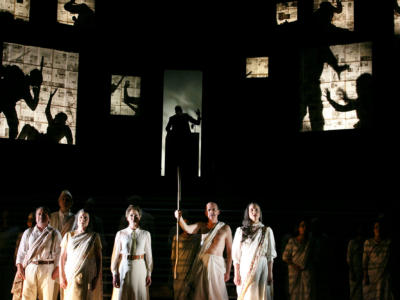Satyagraha: Staging
This production is a collaboration between ENO and theatre company Improbable, directed by Phelim McDermott. It was created in 2007 and has been seen at the Metropolitan Opera, New York, as well as revived at the London Coliseum in 2010 and 2013.
McDermott’s concept stems from his recognition of a connection between the way in which the theatre company Improbable works and Gandhi’s ideal of satyagraha: of people taking responsibility both as individuals and as a collective to enact change. This mirrors Improbable’s work with ensemble casts, bringing together artists of different disciplines.
Although much of the action of Satyagraha tells the story of one man, McDermott brings together in this production a collective of singing and non-singing artists who work together to portray a dramatic narrative that functions on two levels in each scene– that of Gandhi’s storyline and a more abstract evocation of the themes within the opera. In several scenes, members of the Skills Ensemble manipulate striking oversized papier maché figures alongside the principal singers, filling the stage and commenting upon the action.
These abstract features are another way for McDermott to make on-stage sense of the multi-layered and non-linear libretto, in which the audience experience the work’s meaning through different times, spaces and styles, and in which characters collide in unexpected ways. McDermott chooses to physically represent onstage the icons that each act is named after, placing them in vantage points within the set as if they too meditate on the action below. Actors from the Skills Ensemble play the icon figures as silent roles looking down from high windows placed within the set, portraying the overseeing inspiration and embodiment of the ideas of satyagraha.
Video

